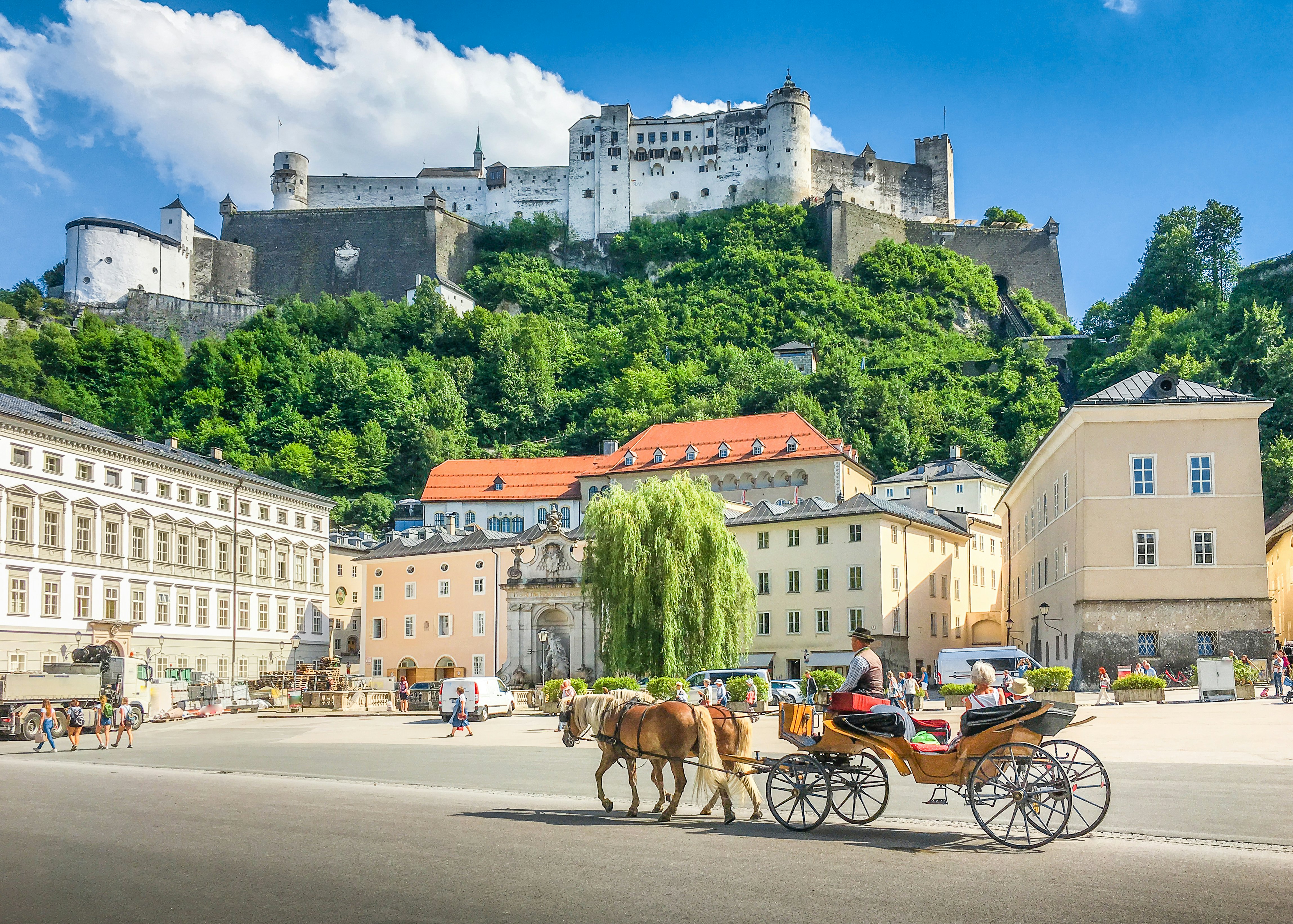
Getting around Salzburg: how to navigate Mozart’s hometown with ease

Jun 12, 2025 • 8 min read

A view over Salzburg, Austria, from the hillside near the Capuchin Monastery. Leanne Irwin/Shutterstock
Beautiful Salzburg is an essential part of any trip to Austria.
The birthplace of Mozart and the setting of The Sound of Music, this delightful city just across the border from southeast Germany is a booming hub of Austrian art and culture. Austria's fourth-largest city is wonderfully walkable, featuring a quaint charm that makes it feel like a friendly town. You'll find an easy-to-navigate network of buses and trollybuses to help you reach areas outside the historic core. You can also cycle your way around, or go back in time with a ride in a traditional horse-drawn carriage.
Here is everything you need to know to make getting around in Salzburg a breeze.

Embrace the excellent bus and trolleybus network...
Punctual, clean and with their own dedicated lanes, buses and trolleybuses are a great way to get around Salzburg, particularly if you wish to venture out of the city center to sights like Schloss Hellbrunn or Salzburg Zoo, both located to the south of town.
Since buses and trolleybuses run until 1am on weekdays and 3am on weekends, these can be a good option for getting home after dinner or a few drinks without ponying up for a taxi. In May 2025, Salzburg added the Guest Mobility Ticket, which allows overnight guests to ride all public transportation in the province of Salzburg for free. As a visitor, you can receive the ticket digitally or as a PDF upon your check-in, and it is valid for the duration of your stay. The ticket is funded by a mobility tax on top of the overnight stay tax. The current fee is €0.50 ($0.57US) per person, per night (for guests aged 15 and over). Otherwise, bus fares run from €2.50 ($2.86US) at vending machines and €3 ($3.43US) onboard, and bus travel is also free with a Salzburg Card (more on that below).
Lines 1 and 4 circle the old town of Altstadt, and tickets can be purchased from the bus driver, or from a tabac stand or ticket machine. These tickets must be validated once on the bus. The main bus stop in the city is located just outside of the Hauptbahnhof (central train station).

...or make like the locals and hop on a bicycle
With more than 180km (112 miles) of bike lanes throughout the city, Salzburg is fast becoming known for this eco-friendly mode of travel. Locking up your bike around town is easy, and the majority of routes take you through parks and off-road areas, making it relatively safe for novice bike riders to enjoy a cycle.
The compact city is easy to get around on two wheels, and a bike ride makes for a lovely day out. One particularly popular route takes cyclists on a leisurely route along the banks of the river Salzach all the way to Schloss Hellbrunn, one of the city’s most popular sights. The river routes themselves make for a relatively easy going; those looking for something more adventurous can head to trails in the mountainous areas outside of the city, such as those at Gaisberg.
Many hotels in the city rent bikes out by the day for a reasonable rate, and some even loan them for free to guests. Plenty of bike rental schemes are on offer, too – such as ListNRide, which allows travelers to rent bikes from locals for about €40 ($45.70US) per day. With plenty of trails and parks to enjoy, a bike rental makes for one of the most appealing options for exploring Salzburg, especially in the summer months.
Taxis are reasonably priced and reliable (but you won’t really need them)
If you travel with lots of heavy luggage, you might want to use a taxi, which can be found around all tourist hot spots and shopping areas. Hailing a ride in the city is not easy, as they are not permitted to stop in certain areas (such as in front of shops or bus stops); it’s easier to call the popular 8111 or use the Taxi 8111 - Salzburg Taxi app.
While Salzburg does have Uber, there are often long wait times, and it’s far more popular to use local taxis and public transport since it is so reliable. Payments can be made via cash or card, with a starting fare of €3.90 ($4.46US) for pre-booked taxis. At night, the starting fare increases by 25%, but this can be worth it if you have been out with friends and want to get home without multiple stops on the night bus.
Since the city center is mainly pedestrianized, taxis will have to drop you off somewhere in the ring around the old town. For example, if you are hoping to see Mozart’s birthplace, you will likely have to be dropped off at Sigmundstor (Austria’s oldest road tunnel and now the eastern entrance to the pedestrianized part of the city), then walk the 10 minutes to your destination.

A Fiaker (horse-drawn hackney coach) is a great way to see the old town
Hop in a Fiaker if you’re feeling extra fancy. These horse-drawn carriages are a popular way for tourists to see the sights of the old town. Carriages can be rented from Residenzplatz in the old town starting at 10am. A short tour of 25 minutes can include sights like Cathedral Square and Alter Markt. With a longer tour of 50 minutes, you can take in newer areas of the city as well as the historic quarters. Prices will vary, though you can expect a 40-minute ride for a maximum of four people to start at about €165 ($188.50US). While such rides are a splurge, they provide a neat way of taking in the charm of the city, especially for first-timers.
No reservations are required. The guides are experienced and knowledgeable, providing your money’s worth in information while on the ride. Fiakers are available year-round, although we can’t really recommend taking an open-top carriage ride in the rain.
Save some money by getting a Salzburg Card
A Salzburg Card provides unlimited use of public transportation as well as access to great attractions. Available for 24, 48 or 72 hours, the card gets the holder admission to a number of major sights and museums, such as Schloss Hellbrunn (which normally costs €15/$17.14US) for adults) and DomQuartier Salzburg (normal admission €15/$17.14US). For the price of entry to just a few museums, the Salzburg card gains access to a plethora of them, with adult prices beginning at €28 (US$32) January-April and November-December, and €31 ($35.42) May-October.
Public transport is included in the price of the ticket – including bus, rail and bus taxi, on multiple lines throughout the city. If you plan on visiting a few museums, catching the bus home from a night out and visiting somewhere like Mozart’s birthplace, the Salzburg Card could save you a great deal in just a couple of days.

Why walking is my favorite way to get around Salzburg
It feels like you can see absolutely everything in Salzburg on foot. While the weather always plays a key factor, the fresh Alpine air makes wandering the old town a pleasure in summer. Come winter, when locals gear up for outdoor Christmas markets and events to celebrate the season, the cold conditions can make exploring the city on foot brisk but still appealing.
The new town is connected to the old town by a variety of pedestrian bridges, making the city extremely accessible. The Aldstadt itself holds many of the city’s sights within walking distance of one another in a fully pedestrianized area. Within just a few easily walkable kilometers of one another are sights like Mozart’s birthplace on the beautiful pedestrian street Getreidegasse; St Peter’s Abbey, cemetery and catacombs; and Hohensalzburg Fortress. Then there is the actual old town itself, a UNESCO World Heritage sight, filled with stunning cathedrals, baroque details and buildings that seem to have been untouched for centuries. What better way to enjoy a city of architecture and museums than by foot?
Accessible transportation in Salzburg
Thanks to the city’s compactness, Salzburg is one of the more accessible cities in Europe for those in wheelchairs and with mobility issues who wish to sightsee. The city is largely flat, with cobblestones laid evenly and no cars permitted within the old town area, making it fairly easy to get around. Many walking tours cater to those with mobility issues, and many popular tourist sights are wheelchair accessible with barrier-free entrances. The city also has many accessible hotels and restaurants, catering to anyone needing extra access and toilet facilities.
Most public transport in Salzburg accommodates wheelchair users with low-entry doors and ramps, meaning that with a little bit of foresight you can easily get outside of the historic center. Downloading the SalzburgMobil app is the ideal way to plan, as it shows all nearby transport options, including those with extra access for people experiencing mobility issues. Discounts are also available to those with extra needs. Keep in mind that since public transportation doesn’t go through the city center, those with limited mobility will have to find their own way through the old town.

How to get to Salzburg from Vienna
From Vienna, hourly ÖBB high-speed trains connect the cities in two and a half hours, with fares of €29.76 ($34US). The Austrian rail network is one of the most reliable in Europe.
Buses from Vienna to Salzburg run multiple times a day, with fast (two and a half hours) and slow (up to nine hours) services available. Tickets can be purchased online starting at €16.63 ($19US) and most services have no stops, taking you directly from city to city.
While there are no direct plane connections to Vienna, Salzburg Airport (only 4km/2.5 miles outside of the city) offers flights to and from many European countries. Buses from the airport to the city center are cheap and frequent, stopping in the city center and surrounding areas, making it extremely easy for travelers to find their hotels.















